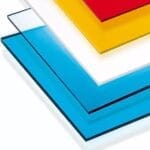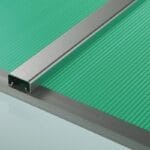 Polycarbonate vs. Glass Skylights: Discover why Domer Contiroof stands out for durability, efficiency, and performance in commercial and industrial buildings.
Polycarbonate vs. Glass Skylights: Discover why Domer Contiroof stands out for durability, efficiency, and performance in commercial and industrial buildings. In the realm of commercial and industrial construction, the choice of materials for skylights can significantly impact the functionality, efficiency, and overall performance of a building. Skylights are essential for harnessing natural light, reducing energy consumption, and enhancing the aesthetic appeal of large structures such as shopping centers, airport hangars, logistic parks, storage warehouses, and industrial buildings. Traditionally, glass has been the go-to material for skylights. However, advancements in material science have introduced superior alternatives: polycarbonate and fiberglass skylights. This article delves into the myriad advantages of using polycarbonate and fiberglass skylights over traditional glass, highlighting factors such as superior heat insulation, lighter weight, easier installation, better adaptability to thermal movements, UV protection, IR control, improved solar heat gain coefficient (SHGC), and shading efficiency.
Superior Heat Insulation
One of the paramount advantages of polycarbonate and fiberglass skylights is their superior heat insulation properties compared to glass. These materials are designed to provide excellent thermal insulation, which is crucial in maintaining a comfortable indoor environment. Polycarbonate, in particular, has a lower thermal conductivity than glass, meaning it does not transfer heat as readily. This results in reduced heat loss during the winter and less heat gain during the summer, contributing to significant energy savings on heating and cooling costs. In commercial settings like shopping centers and airport hangars, where temperature control is vital, polycarbonate and fiberglass skylights offer a substantial improvement in thermal efficiency.
Lightweight and Easier Installation
Polycarbonate and fiberglass skylights are significantly lighter than glass, making them easier to handle and install. The lightweight nature of these materials reduces the structural load on buildings, allowing for more design flexibility and potentially lower construction costs. For large-scale industrial buildings, such as logistic parks and storage warehouses, the ease of installation translates to shorter construction times and reduced labor costs. Additionally, the lightweight properties of polycarbonate and fiberglass reduce the risk of injury during installation, enhancing worker safety.
Better Adaptability to Thermal Movements
Buildings, especially large commercial and industrial structures, are subject to thermal expansion and contraction due to temperature fluctuations. Polycarbonate and fiberglass skylights have a distinct advantage over glass in this regard. These materials are more flexible and can absorb and accommodate the thermal movements of buildings without cracking or breaking. This adaptability ensures the longevity and durability of the skylights, reducing maintenance costs and the need for frequent replacements. In environments like airport hangars and industrial buildings, where structural integrity is critical, the resilience of polycarbonate and fiberglass skylights is invaluable.
UV Protection
One of the significant concerns with skylights is the potential for harmful ultraviolet (UV) rays to penetrate the building, causing damage to interiors and posing health risks to occupants. Polycarbonate and fiberglass skylights excel in providing UV protection, reflecting up to 99.99% of harmful UV rays. This level of protection not only safeguards the health of building occupants but also prevents the fading and deterioration of furnishings, equipment, and merchandise. In commercial settings like shopping centers, where the protection of goods and comfort of shoppers is paramount, the UV-blocking capabilities of polycarbonate and fiberglass skylights are a significant advantage.
IR Control
Infrared (IR) radiation from the sun can contribute to excessive heat buildup inside buildings, leading to increased cooling demands and higher energy costs. Polycarbonate and fiberglass skylights can be engineered to control IR radiation, minimizing heat gain while still allowing ample natural light to enter. This IR control is particularly beneficial in climates with high solar intensity, where managing indoor temperatures is a constant challenge. By reducing the reliance on artificial cooling systems, these skylights help lower energy consumption and promote a more sustainable building operation.
Improved Solar Heat Gain Coefficient (SHGC) and Shading Efficiency
The Solar Heat Gain Coefficient (SHGC) is a measure of how much solar radiation is admitted through a skylight. Polycarbonate and fiberglass skylights offer improved SHGC values compared to glass, meaning they can better control the amount of solar heat that enters a building. This enhanced performance is complemented by superior shading efficiency, which reduces glare and improves the comfort of indoor spaces. For industrial buildings and storage warehouses, where consistent indoor conditions are necessary for the preservation of goods, the improved SHGC and shading efficiency of polycarbonate and fiberglass skylights provide a significant operational advantage.
Impact Resistance and Safety
Safety is a critical consideration in the design and construction of commercial and industrial buildings. Polycarbonate and fiberglass skylights are known for their high impact resistance, making them a safer alternative to glass. In the event of severe weather conditions, such as hailstorms or strong winds, these materials are less likely to shatter, reducing the risk of injury and damage to property. This robustness is particularly important in areas prone to extreme weather, where the durability of building materials is constantly tested.
Cost-Effectiveness
While the initial cost of polycarbonate and fiberglass skylights may be comparable to or slightly higher than glass, the long-term cost savings are significant. The superior thermal insulation properties of these materials lead to reduced energy consumption and lower utility bills. Additionally, their durability and low maintenance requirements result in fewer repairs and replacements over the lifespan of the skylights. For large-scale commercial and industrial projects, these cost savings can be substantial, making polycarbonate and fiberglass skylights a more economical choice in the long run.
Aesthetic Flexibility and Design Versatility
Polycarbonate and fiberglass skylights offer greater design flexibility and aesthetic versatility compared to glass. These materials can be molded into various shapes and sizes, allowing architects and designers to create unique and innovative skylight designs that enhance the visual appeal of buildings. The availability of different colors and finishes further adds to the design possibilities, enabling the creation of customized skylight solutions that meet specific aesthetic and functional requirements. In commercial spaces like shopping centers, where visual appeal plays a crucial role in attracting customers, the design versatility of polycarbonate and fiberglass skylights is a distinct advantage.
Environmental Benefits
Sustainability is a growing concern in the construction industry, and the use of environmentally friendly materials is becoming increasingly important. Polycarbonate and fiberglass skylights are more sustainable options compared to glass, as they require less energy to manufacture and transport. Additionally, these materials can be recycled at the end of their useful life, reducing their environmental impact. By choosing polycarbonate and fiberglass skylights, builders and developers can contribute to greener construction practices and promote environmental stewardship.
Conclusion
In summary, polycarbonate and fiberglass skylights offer a multitude of advantages over traditional glass skylights in commercial and industrial buildings. From superior heat insulation and lightweight properties to better adaptability to thermal movements and exceptional UV protection, these materials provide significant performance, safety, and cost benefits. Their impact resistance, design versatility, and environmental friendliness further enhance their appeal, making them the preferred choice for modern construction projects. As the demand for energy-efficient and sustainable building solutions continues to rise, polycarbonate and fiberglass skylights are poised to play a pivotal role in shaping the future of commercial and industrial architecture.
For more information on the benefits of polycarbonate and fiberglass skylights and to explore our range of skylight solutions, Contact our Domer Skylights Specialists. Our commitment to innovation and quality ensures that you receive the best products for your building projects.




























